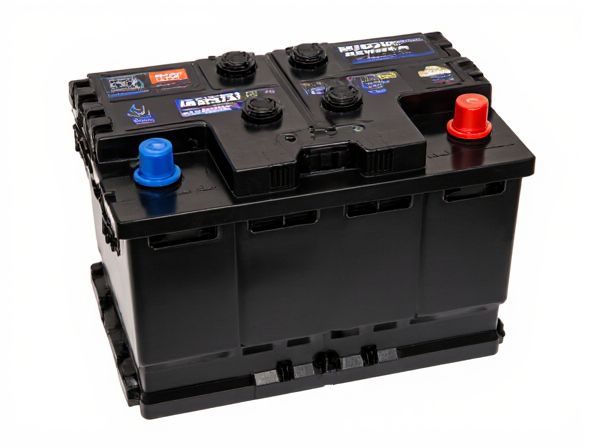
Photo illustration: Marine Cranking vs Dual Purpose
Marine cranking batteries are specifically designed to provide high burst power to start boat engines quickly, ensuring reliable ignition in marine environments. Dual purpose batteries combine starting power with deep cycling capabilities, making them versatile for running onboard electronics and lighting after starting the engine. Your choice depends on whether you prioritize short bursts of energy for engine starts or sustained power for multiple functions onboard.
Table of Comparison
| Feature | Marine Cranking Battery | Dual Purpose Battery |
|---|---|---|
| Primary Use | Starting marine engines | Starting engines + deep cycle applications |
| Cranking Amps | High | Moderate |
| Deep Cycle Capability | Low | High |
| Battery Life | Shorter under deep cycling | Longer with mixed use |
| Typical Applications | Boat starters | Boat starters + trolling motors, electronics |
| Cost | Generally lower | Higher due to versatility |
| Recommended For | Frequent engine starts, low accessory use | Engine starting plus extended accessory power |
Understanding Marine Cranking and Dual Purpose Batteries
Marine cranking batteries deliver high bursts of power required for starting boat engines, providing rapid ignition even in cold conditions. Dual purpose batteries combine the high cranking power of starting batteries with deep cycle capabilities, allowing prolonged energy discharge to power onboard electronics and accessories. Understanding the distinction between marine cranking and dual purpose batteries ensures optimal performance for both engine starting and extended energy demands on marine vessels.
Key Differences Between Cranking and Dual Purpose Batteries
Marine cranking batteries are designed to deliver high bursts of power for starting boat engines, emphasizing maximum cold cranking amps (CCA) to ensure reliable ignition in harsh marine conditions. Dual purpose batteries combine starting power and deep cycle capability, enabling them to provide sustained energy for trolling motors and onboard electronics while also starting the engine. The key difference lies in cranking batteries prioritizing short-term high current output, whereas dual purpose batteries balance between engine starting and long-lasting cycle performance.
Core Functions of Marine Cranking Batteries
Marine cranking batteries specialize in delivering high bursts of power to initiate engine startup, ensuring rapid ignition in harsh marine environments. These batteries feature robust lead-acid plates with thick separators designed for durability and resistance to vibration and corrosion. Unlike dual-purpose batteries, marine cranking batteries prioritize instant amperage output over deep cycle endurance, optimizing their core function for reliable engine cranking performance.
Features and Advantages of Dual Purpose Batteries
Dual purpose batteries combine the high cranking power of marine starting batteries with the deep cycling capabilities of marine deep cycle batteries, making them ideal for boats requiring both engine starting and sustained power for accessories. They feature robust plate design and thicker plates, ensuring durability, longer service life, and resistance to vibration and corrosion in marine environments. These batteries provide reliable starting power and steady, deep energy discharge for powering electronics, trolling motors, and other onboard equipment, offering versatile performance and reduced need for multiple battery systems.
Performance Comparison: Cranking Vs Dual Purpose
Marine cranking batteries deliver high cold-cranking amps (CCA) designed to start engines quickly in harsh marine environments. Dual purpose batteries balance moderate cranking power with deep cycling capability, supporting both engine starting and auxiliary electrical loads. Performance comparison shows cranking batteries excel in rapid engine starts, while dual purpose batteries offer greater versatility for prolonged power usage and marine electronics.
Application Scenarios: Which Battery for Your Boat?
Marine cranking batteries excel in high-voltage bursts needed to start boat engines, making them ideal for powerboats and fishing boats that require reliable engine ignition. Dual purpose batteries combine cranking power with deep cycling capabilities for running onboard electronics and accessories, suitable for sailboats and vessels with multiple electrical demands. Choosing between marine cranking and dual purpose batteries depends on engine start frequency and the extent of auxiliary power use during trips.
Lifespan and Maintenance Considerations
Marine cranking batteries are designed for short bursts of high power to start engines and generally have a shorter lifespan of around 3-5 years due to their construction optimized for quick energy delivery. Dual-purpose batteries combine starting and deep cycling capabilities, offering a longer lifespan of 4-6 years by balancing cranking power with reserve capacity, but require more diligent maintenance to prevent sulfation and ensure optimal performance. Regular inspection of electrolyte levels and proper charging are critical for extending the life of both battery types in marine environments.
Cost Analysis: Investment and Value
Marine cranking batteries generally offer a lower upfront investment compared to dual-purpose batteries, making them cost-effective for applications focused solely on engine starting. Dual-purpose batteries provide added value by combining starting power with deep cycling capabilities, reducing the need for multiple batteries and saving long-term replacement costs. While dual-purpose batteries have a higher initial price, their versatility and extended lifespan often result in better overall return on investment for marine enthusiasts.
Installation Best Practices for Marine Batteries
Marine cranking batteries require secure mounting in a well-ventilated, dry compartment near the engine to optimize starting power, whereas dual-purpose batteries benefit from placement that balances both engine starting access and deep cycle usage. Using stainless steel hardware and proper terminal protection prevents corrosion and ensures consistent electrical connections. Regular inspection and adherence to manufacturer torque specifications are essential for safe and efficient battery operation in marine environments.
Choosing the Right Battery for Your Marine Needs
Choosing the right battery for your marine needs depends on understanding the specific advantages of marine cranking versus dual-purpose batteries. Marine cranking batteries offer high cold-cranking amps (CCA) to reliably start your engine in challenging conditions, making them ideal for boats with high-starting power requirements. Dual-purpose batteries combine sufficient starting power with deep cycling capability, supporting both engine ignition and powering onboard electronics, which suits vessels with extensive electrical demands.
 caratoz.com
caratoz.com